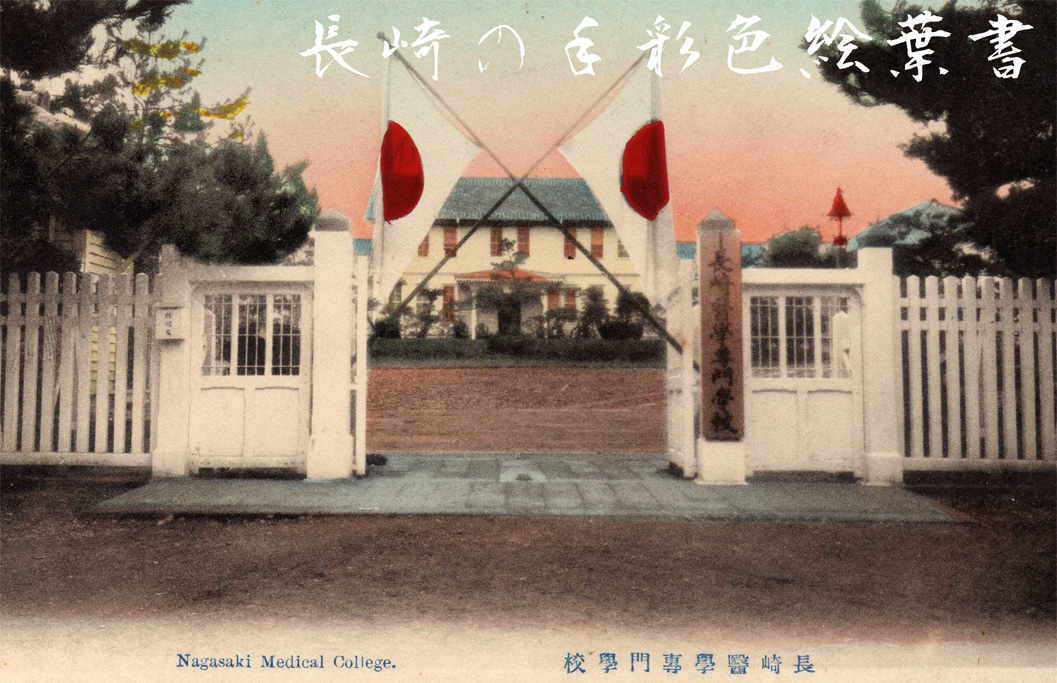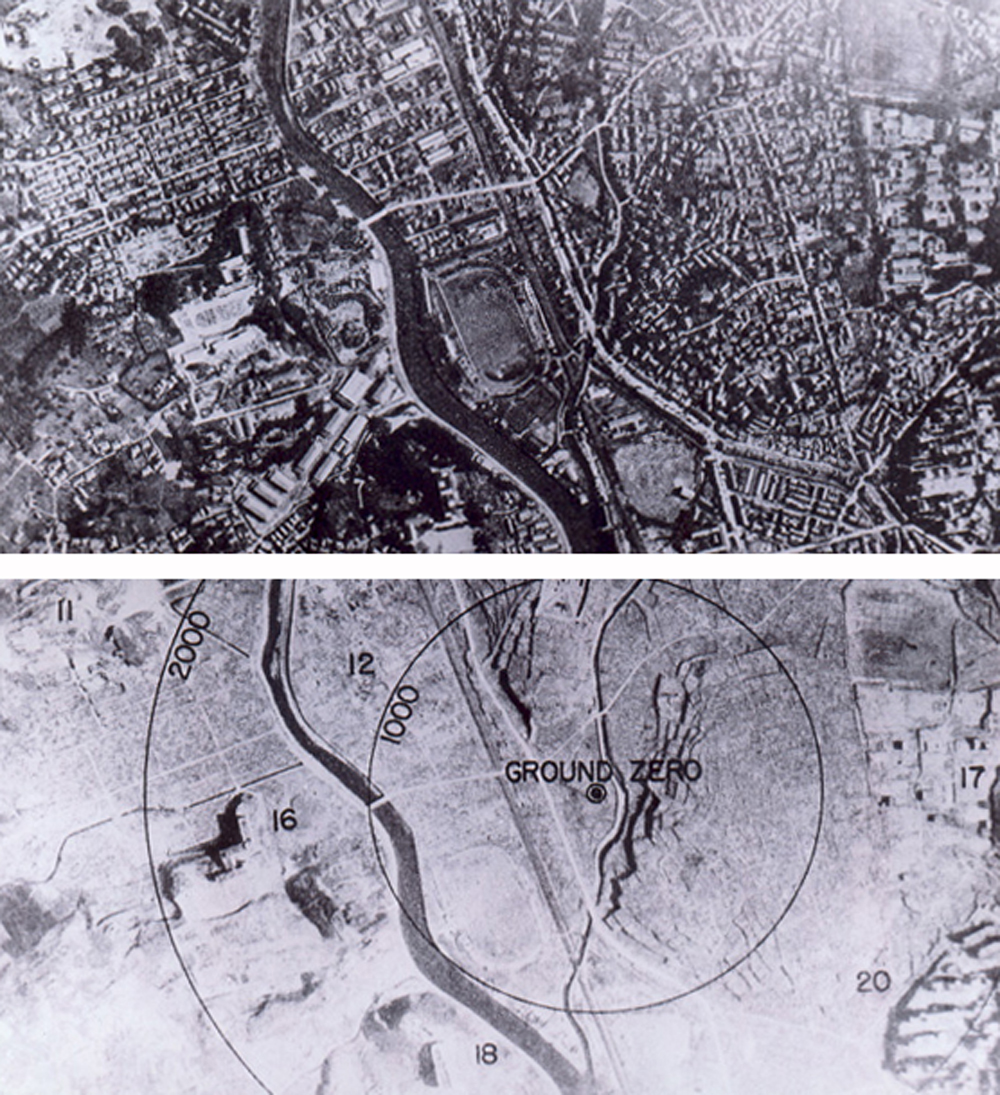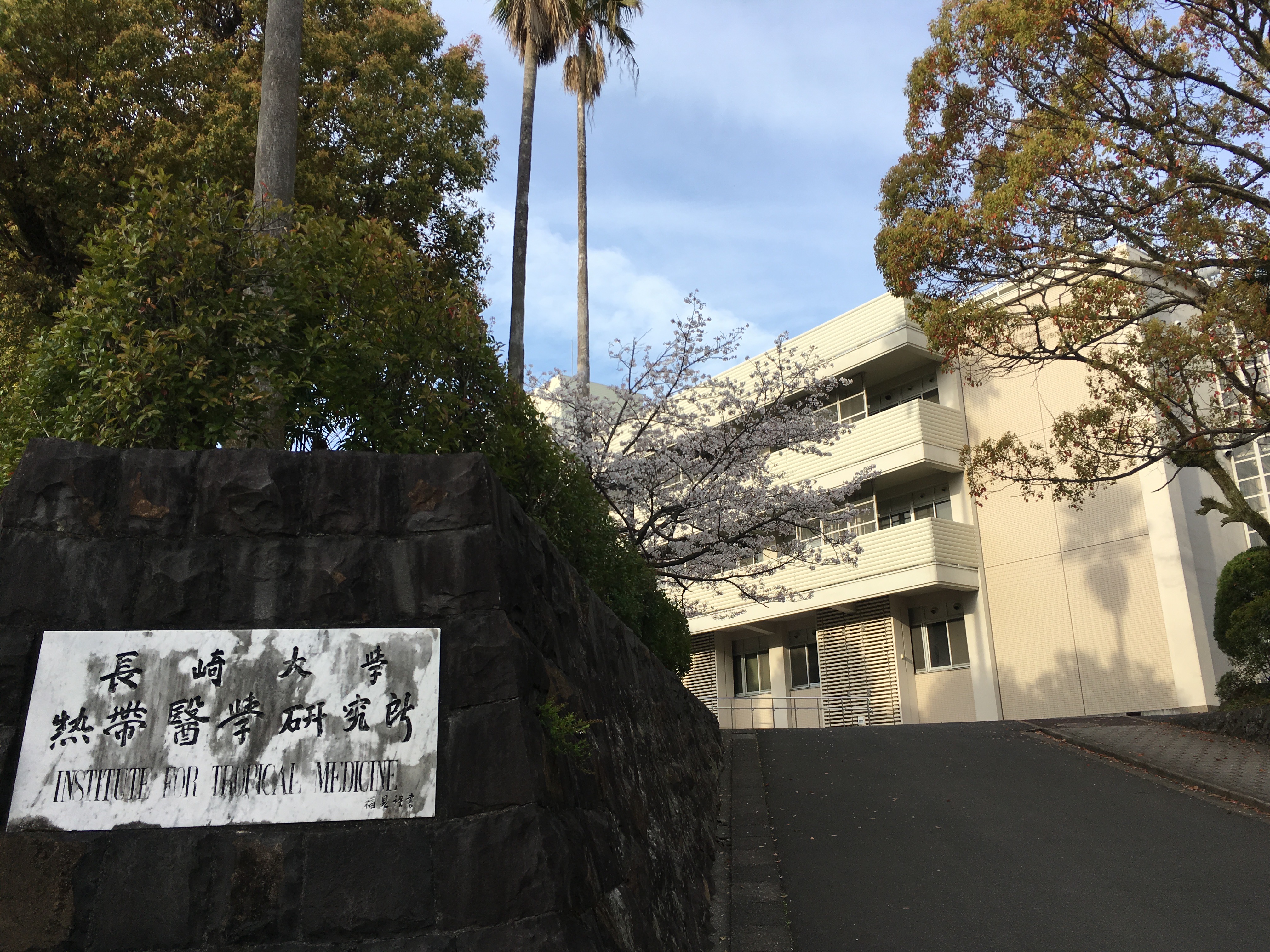Nagasaki University on:
[Wikipedia]
[Google]
[Amazon]
is a national university of Japan. Its nickname is ''Chōdai'' (). The main campus is located in Bunkyo-machi, Nagasaki City,


 Nagasaki University was established in 1949 by incorporating several national institutions, namely, Nagasaki Medical College (including College Hospital and College of Pharmaceutical Sciences), Nagasaki College of Economics, Nagasaki Normal School, Nagasaki Youth Normal School and Nagasaki High School.
The new main campus (Bunkyo Campus) was formerly a plant site of Mitsubishi Arms Factory (Ohashi Plant).
Nagasaki University was established in 1949 by incorporating several national institutions, namely, Nagasaki Medical College (including College Hospital and College of Pharmaceutical Sciences), Nagasaki College of Economics, Nagasaki Normal School, Nagasaki Youth Normal School and Nagasaki High School.
The new main campus (Bunkyo Campus) was formerly a plant site of Mitsubishi Arms Factory (Ohashi Plant).
 The Institute of Tropical Medicine (長崎大学熱帯医学研究所], NEKKEN or NUITM) was originally founded under Nagasaki Medical College to perform basic and applied studies on endemic diseases in East Asia. In 1949, the institute merged with other facilities to form Nagasaki University under the new ruling of the National School Establishment Law.
Since 1946, researchers at NUITM have conducted fundamental and applied studies on tropical medicine, tropical and emerging diseases. This includes infectious disease epidemiology studies and vaccine and therapeutics development against infectious diseases. Researchers at NUITM have established several international research partnerships, including in Vietnam the Philippines, and Kenya, to study emerging and re-emerging diseases. The institute has research stations in Vietnam and Kenya, and of note, the field research conducted in Kenya has inspired a popular song, novel, and charity foundation, and has been featured in a film, '' The Lion Standing in the Wind''.
As one of the world's leading institutes for training and research in tropical medicine and health care, it is stipulated as a Joint Usage/ Research Center under the Ministry of Education, Culture, Sports, Science and Technology (MEXT) to spear-head academic research, and is a member of the Japan Infectious Disease Research Consortium that includes Institute of Medical Science (Japan), Osaka University and
The Institute of Tropical Medicine (長崎大学熱帯医学研究所], NEKKEN or NUITM) was originally founded under Nagasaki Medical College to perform basic and applied studies on endemic diseases in East Asia. In 1949, the institute merged with other facilities to form Nagasaki University under the new ruling of the National School Establishment Law.
Since 1946, researchers at NUITM have conducted fundamental and applied studies on tropical medicine, tropical and emerging diseases. This includes infectious disease epidemiology studies and vaccine and therapeutics development against infectious diseases. Researchers at NUITM have established several international research partnerships, including in Vietnam the Philippines, and Kenya, to study emerging and re-emerging diseases. The institute has research stations in Vietnam and Kenya, and of note, the field research conducted in Kenya has inspired a popular song, novel, and charity foundation, and has been featured in a film, '' The Lion Standing in the Wind''.
As one of the world's leading institutes for training and research in tropical medicine and health care, it is stipulated as a Joint Usage/ Research Center under the Ministry of Education, Culture, Sports, Science and Technology (MEXT) to spear-head academic research, and is a member of the Japan Infectious Disease Research Consortium that includes Institute of Medical Science (Japan), Osaka University and
Nagasaki University
{{Authority control Japanese national universities Buildings and structures in Nagasaki Universities and colleges in Nagasaki Prefecture Medical research institutes in Japan Tropical medicine organizations Virology institutes 1942 establishments in Japan
Nagasaki Prefecture
is a prefecture of Japan located on the island of Kyūshū. Nagasaki Prefecture has a population of 1,314,078 (1 June 2020) and has a geographic area of 4,130 km2 (1,594 sq mi). Nagasaki Prefecture borders Saga Prefecture to the northeast.
N ...
, Japan.
History


 Nagasaki University was established in 1949 by incorporating several national institutions, namely, Nagasaki Medical College (including College Hospital and College of Pharmaceutical Sciences), Nagasaki College of Economics, Nagasaki Normal School, Nagasaki Youth Normal School and Nagasaki High School.
The new main campus (Bunkyo Campus) was formerly a plant site of Mitsubishi Arms Factory (Ohashi Plant).
Nagasaki University was established in 1949 by incorporating several national institutions, namely, Nagasaki Medical College (including College Hospital and College of Pharmaceutical Sciences), Nagasaki College of Economics, Nagasaki Normal School, Nagasaki Youth Normal School and Nagasaki High School.
The new main campus (Bunkyo Campus) was formerly a plant site of Mitsubishi Arms Factory (Ohashi Plant).
Nagasaki Medical College
The oldest of the predecessors was Nagasaki Medical College. It was founded in November 1857 as by the branch office ofTokugawa Shogunate
The Tokugawa shogunate (, Japanese 徳川幕府 ''Tokugawa bakufu''), also known as the , was the military government of Japan during the Edo period from 1603 to 1868. Nussbaum, Louis-Frédéric. (2005)"''Tokugawa-jidai''"in ''Japan Encyclopedia ...
. The first professor was J. L. C. Pompe van Meerdervoort, and the institute was one of the first western-style (not '' Kampō'') medical schools in Japan. In 1861 the hospital was founded, and after Meiji Restoration
The , referred to at the time as the , and also known as the Meiji Renovation, Revolution, Regeneration, Reform, or Renewal, was a political event that restored practical imperial rule to Japan in 1868 under Emperor Meiji. Although there were ...
the school became a public (prefectural, later national) medical school. It was developed into in 1901, then into in 1923.
After Japan participated in the Pacific War, the medical college added several institutes for the war, such as Temporary College of Medicine (1940) and East Asia Research Institute of Endemics (1942, Institute of Tropical Medicine today). On August 9, 1945 the college was heavily damaged by the atomic bomb, because it was located only 500 to 700 meters away from the hypocenter
In seismology, a hypocenter or hypocentre () is the point of origin of an earthquake or a subsurface nuclear explosion. A synonym is the focus of an earthquake.
Earthquakes
An earthquake's hypocenter is the position where the strain energy ...
. Over 800 professors, students and medical workers were killed. The college was moved to Omura in September 1945, and then to Isahaya in 1946. The old campus (Sakamoto Campus) was restored later in 1950, after the college was integrated into Nagasaki University.
Institute of Tropical Medicine
 The Institute of Tropical Medicine (長崎大学熱帯医学研究所], NEKKEN or NUITM) was originally founded under Nagasaki Medical College to perform basic and applied studies on endemic diseases in East Asia. In 1949, the institute merged with other facilities to form Nagasaki University under the new ruling of the National School Establishment Law.
Since 1946, researchers at NUITM have conducted fundamental and applied studies on tropical medicine, tropical and emerging diseases. This includes infectious disease epidemiology studies and vaccine and therapeutics development against infectious diseases. Researchers at NUITM have established several international research partnerships, including in Vietnam the Philippines, and Kenya, to study emerging and re-emerging diseases. The institute has research stations in Vietnam and Kenya, and of note, the field research conducted in Kenya has inspired a popular song, novel, and charity foundation, and has been featured in a film, '' The Lion Standing in the Wind''.
As one of the world's leading institutes for training and research in tropical medicine and health care, it is stipulated as a Joint Usage/ Research Center under the Ministry of Education, Culture, Sports, Science and Technology (MEXT) to spear-head academic research, and is a member of the Japan Infectious Disease Research Consortium that includes Institute of Medical Science (Japan), Osaka University and
The Institute of Tropical Medicine (長崎大学熱帯医学研究所], NEKKEN or NUITM) was originally founded under Nagasaki Medical College to perform basic and applied studies on endemic diseases in East Asia. In 1949, the institute merged with other facilities to form Nagasaki University under the new ruling of the National School Establishment Law.
Since 1946, researchers at NUITM have conducted fundamental and applied studies on tropical medicine, tropical and emerging diseases. This includes infectious disease epidemiology studies and vaccine and therapeutics development against infectious diseases. Researchers at NUITM have established several international research partnerships, including in Vietnam the Philippines, and Kenya, to study emerging and re-emerging diseases. The institute has research stations in Vietnam and Kenya, and of note, the field research conducted in Kenya has inspired a popular song, novel, and charity foundation, and has been featured in a film, '' The Lion Standing in the Wind''.
As one of the world's leading institutes for training and research in tropical medicine and health care, it is stipulated as a Joint Usage/ Research Center under the Ministry of Education, Culture, Sports, Science and Technology (MEXT) to spear-head academic research, and is a member of the Japan Infectious Disease Research Consortium that includes Institute of Medical Science (Japan), Osaka University and Hokkaido University
, or , is a Japanese national university in Sapporo, Hokkaido. It was the fifth Imperial University in Japan, which were established to be the nation's finest institutions of higher education or research. Hokkaido University is considered ...
.
With over one hundred graduate students enrolled, NUITM carries out an extensive capacity strengthening program in counterpart countries, and collaborates with a large network of institutions in Africa, South America, and Asia through MEXT, Japan International Cooperation Agency
The is a governmental agency that delivers the bulk of Official Development Assistance (ODA) for the government of Japan. It is chartered with assisting economic and social growth in developing countries, and the promotion of international co ...
(JICA), Official Development Assistance (Japan) (ODA), Japan Agency for Medical Research and Development (AMED) and the WHO
Who or WHO may refer to:
* Who (pronoun), an interrogative or relative pronoun
* Who?, one of the Five Ws in journalism
* World Health Organization
Arts and entertainment Fictional characters
* Who, a creature in the Dr. Seuss book '' Horton He ...
. The institute acts as a WHO
Who or WHO may refer to:
* Who (pronoun), an interrogative or relative pronoun
* Who?, one of the Five Ws in journalism
* World Health Organization
Arts and entertainment Fictional characters
* Who, a creature in the Dr. Seuss book '' Horton He ...
Collaborating Center for Research and Reference of Tropical and Emerging Viral Diseases and as the WHO's reference laboratories, providing confirmatory testing for COVID-19
Coronavirus disease 2019 (COVID-19) is a contagious disease caused by a virus, the severe acute respiratory syndrome coronavirus 2 (SARS-CoV-2). The first known case was identified in Wuhan, China, in December 2019. The disease quickly ...
.
In response to the COVID-19 pandemic
The COVID-19 pandemic, also known as the coronavirus pandemic, is an ongoing global pandemic of coronavirus disease 2019 (COVID-19) caused by severe acute respiratory syndrome coronavirus 2 (SARS-CoV-2). The novel virus was first identi ...
, the institute led the International Infectious Disease Consortium against COVID-19 (grant-in-aid emergency fund), an international research collaboration to develop countermeasures against the novel coronavirus, SARS-CoV-2.
Researchers at NUITM, in collaboration with local public health institutes, initiated efforts in diagnosing SARS-CoV-2, including developing new diagnostic tools. Technology transfer and collaboration with Southeast Asian counterparts has shed light on how the disease spread in Japan and Southeast Asia.
Nagasaki College of Economics
Another notable predecessor was Nagasaki College of Economics. It was founded in March 1905 as . It was the fourth national commercial college in Japan, afterTokyo
Tokyo (; ja, 東京, , ), officially the Tokyo Metropolis ( ja, 東京都, label=none, ), is the capital and List of cities in Japan, largest city of Japan. Formerly known as Edo, its metropolitan area () is the most populous in the world, ...
(1887), Kobe (1902) and Yamaguchi (February 1905), and aimed at educating students so that they could engage in business with China, Korea and Southeast Asia. In 1917 it added the Advanced Course for Trade (one-year course), and the building for the course was built in 1919 (Keirin Hall today).
In 1944 it was renamed . On August 9, 1945 although Nagasaki underwent the atomic bombing, the college buildings were protected by Mt. Kompira. Its campus (Katafuchi Campus) has been used by the Faculty of Economics, Nagasaki University.
Undergraduate schools
;Bunkyo Campus * School of Global Humanities and Social Sciences * Faculty of Education * Faculty of Pharmaceutical Sciences * Faculty of Engineering * Faculty of Environmental Studies * Faculty of Fisheries ;Sakamoto Campus * School of Medicine * School of Dentistry ;Katafuchi Campus * Faculty of EconomicsGraduate schools
* Graduate School of Education (Master's courses only) * Graduate School of Economics * Graduate School of Science and Technology * Graduate School of Biomedical Sciences * Graduate School of International Health Development (Master's courses only) * Graduate School of Global Humanities and Social SciencesResearch institutes
* Atomic Bomb Disease Institute, Nagasaki University Graduate School of Biomedical SciencesCollaboration and MoU with foreign universities and institutes
* Islamic University, Bangladesh (MoU) Controversy
In April 2019, Nagasaki University came under fire for banning smokers from their campus. This would prevent teachers from getting hired. Many smokers and non-smokers felt that the measure was discriminatory against smokers and their personal lives. Many also argued that smoking is not relevant to their employment.
Several people have filed lawsuits against the university for discrimination. However, no lawsuit has been currently settled.
Notable alumni
* Takashi Nagai,physician
A physician (American English), medical practitioner (Commonwealth English), medical doctor, or simply doctor, is a health professional who practices medicine, which is concerned with promoting, maintaining or restoring health through th ...
specializing in radiology
Radiology ( ) is the medical discipline that uses medical imaging to diagnose diseases and guide their treatment, within the bodies of humans and other animals. It began with radiography (which is why its name has a root referring to radiat ...
, an A-bomb victim.
* Osamu Shimomura
was a Japanese organic chemist and marine biologist, and Professor Emeritus at Marine Biological Laboratory (MBL) in Woods Hole, Massachusetts and Boston University School of Medicine. He was awarded the Nobel Prize in Chemistry in 2008 for th ...
, organic chemist
A chemist (from Greek ''chēm(ía)'' alchemy; replacing ''chymist'' from Medieval Latin ''alchemist'') is a scientist trained in the study of chemistry. Chemists study the composition of matter and its properties. Chemists carefully describe t ...
and marine biologist
A biologist is a scientist who conducts research in biology. Biologists are interested in studying life on Earth, whether it is an individual Cell (biology), cell, a multicellular organism, or a Community (ecology), community of Biological inter ...
, awarded the Nobel Prize in Chemistry
)
, image = Nobel Prize.png
, alt = A golden medallion with an embossed image of a bearded man facing left in profile. To the left of the man is the text "ALFR•" then "NOBEL", and on the right, the text (smaller) "NAT•" then "M ...
in 2008 for his discovery and development of green fluorescent protein with two American chemists.
See also
*Tropical disease
Tropical diseases are diseases that are prevalent in or unique to tropical and subtropical regions. The diseases are less prevalent in temperate climates, due in part to the occurrence of a cold season, which controls the insect population by for ...
* Neglected tropical diseases
* WHO
Who or WHO may refer to:
* Who (pronoun), an interrogative or relative pronoun
* Who?, one of the Five Ws in journalism
* World Health Organization
Arts and entertainment Fictional characters
* Who, a creature in the Dr. Seuss book '' Horton He ...
References
External links
Nagasaki University
{{Authority control Japanese national universities Buildings and structures in Nagasaki Universities and colleges in Nagasaki Prefecture Medical research institutes in Japan Tropical medicine organizations Virology institutes 1942 establishments in Japan